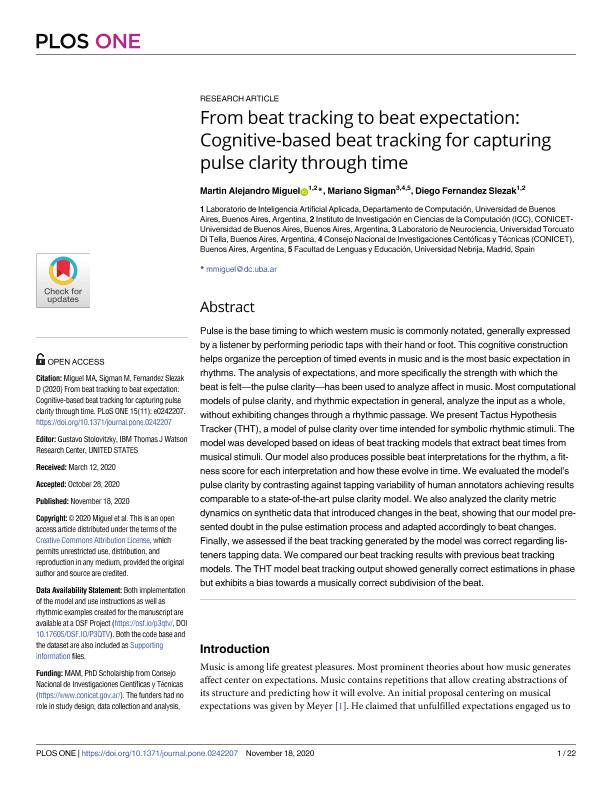Mostrar el registro sencillo del ítem
dc.contributor.author
Miguel, Martín Alejandro

dc.contributor.author
Sigman, Mariano

dc.contributor.author
Fernandez Slezak, Diego

dc.date.available
2021-09-23T16:16:49Z
dc.date.issued
2020-11
dc.identifier.citation
Miguel, Martín Alejandro; Sigman, Mariano; Fernandez Slezak, Diego; From beat tracking to beat expectation: Cognitive-based beat tracking for capturing pulse clarity through time; Public Library of Science; Plos One; 15; 11; 11-2020; 1-22; e0242207
dc.identifier.issn
1932-6203
dc.identifier.uri
http://hdl.handle.net/11336/141379
dc.description.abstract
Pulse is the base timing to which western music is commonly notated, generally expressed by a listener by performing periodic taps with their hand or foot. This cognitive construction helps organize the perception of timed events in music and is the most basic expectation in rhythms. The analysis of expectations, and more specifically the strength with which the beat is felt—the pulse clarity—has been used to analyze affect in music. Most computational models of pulse clarity, and rhythmic expectation in general, analyze the input as a whole, without exhibiting changes through a rhythmic passage. We present Tactus Hypothesis Tracker (THT), a model of pulse clarity over time intended for symbolic rhythmic stimuli. The model was developed based on ideas of beat tracking models that extract beat times from musical stimuli. Our model also produces possible beat interpretations for the rhythm, a fitness score for each interpretation and how these evolve in time. We evaluated the model’s pulse clarity by contrasting against tapping variability of human annotators achieving results comparable to a state-of-the-art pulse clarity model. We also analyzed the clarity metric dynamics on synthetic data that introduced changes in the beat, showing that our model presented doubt in the pulse estimation process and adapted accordingly to beat changes. Finally, we assessed if the beat tracking generated by the model was correct regarding listeners tapping data. We compared our beat tracking results with previous beat tracking models. The THT model beat tracking output showed generally correct estimations in phase but exhibits a bias towards a musically correct subdivision of the beat.
dc.format
application/pdf
dc.language.iso
eng
dc.publisher
Public Library of Science

dc.rights
info:eu-repo/semantics/openAccess
dc.rights.uri
https://creativecommons.org/licenses/by/2.5/ar/
dc.subject
Cognitive modeling
dc.subject
Artificial intelligence
dc.subject
Musicology
dc.subject.classification
Ciencias de la Computación

dc.subject.classification
Ciencias de la Computación e Información

dc.subject.classification
CIENCIAS NATURALES Y EXACTAS

dc.title
From beat tracking to beat expectation: Cognitive-based beat tracking for capturing pulse clarity through time
dc.type
info:eu-repo/semantics/article
dc.type
info:ar-repo/semantics/artículo
dc.type
info:eu-repo/semantics/publishedVersion
dc.date.updated
2021-04-28T21:05:00Z
dc.journal.volume
15
dc.journal.number
11
dc.journal.pagination
1-22; e0242207
dc.journal.pais
Estados Unidos

dc.journal.ciudad
San Francisco
dc.description.fil
Fil: Miguel, Martín Alejandro. Consejo Nacional de Investigaciones Científicas y Técnicas. Oficina de Coordinación Administrativa Ciudad Universitaria. Instituto de Investigación en Ciencias de la Computación. Universidad de Buenos Aires. Facultad de Ciencias Exactas y Naturales. Instituto de Investigación en Ciencias de la Computación; Argentina. Universidad de Buenos Aires. Facultad de Ciencias Exactas y Naturales. Departamento de Computación; Argentina
dc.description.fil
Fil: Sigman, Mariano. Universidad Nebrija. Facultad de Lenguas y Educación; España. Consejo Nacional de Investigaciones Científicas y Técnicas; Argentina. Universidad Torcuato Di Tella; Argentina
dc.description.fil
Fil: Fernandez Slezak, Diego. Consejo Nacional de Investigaciones Científicas y Técnicas. Oficina de Coordinación Administrativa Ciudad Universitaria. Instituto de Investigación en Ciencias de la Computación. Universidad de Buenos Aires. Facultad de Ciencias Exactas y Naturales. Instituto de Investigación en Ciencias de la Computación; Argentina. Universidad de Buenos Aires. Facultad de Ciencias Exactas y Naturales. Departamento de Computación; Argentina
dc.journal.title
Plos One

dc.relation.alternativeid
info:eu-repo/semantics/altIdentifier/url/https://dx.plos.org/10.1371/journal.pone.0242207
dc.relation.alternativeid
info:eu-repo/semantics/altIdentifier/doi/http://dx.doi.org/10.1371/journal.pone.0242207
Archivos asociados
